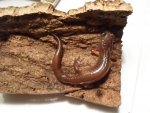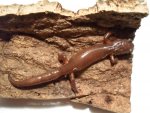firedreams
2010 Research Grant Donor
Hi,
I was wondering if anyone out there could i.d. this salamander? I think its an Ensatina salamander - possibly a Monterey? I will be inheriting the salamander in a few days from a friend. Apparently it arrived in Canada on a shipment of evergreens from the USA a few years ago. I have looked at the Staniszewski care sheet for Ensatinas, but I would also appreciate any additional suggestions that members may have regarding Ensatina care!
Best,
Lydia
I was wondering if anyone out there could i.d. this salamander? I think its an Ensatina salamander - possibly a Monterey? I will be inheriting the salamander in a few days from a friend. Apparently it arrived in Canada on a shipment of evergreens from the USA a few years ago. I have looked at the Staniszewski care sheet for Ensatinas, but I would also appreciate any additional suggestions that members may have regarding Ensatina care!
Best,
Lydia



